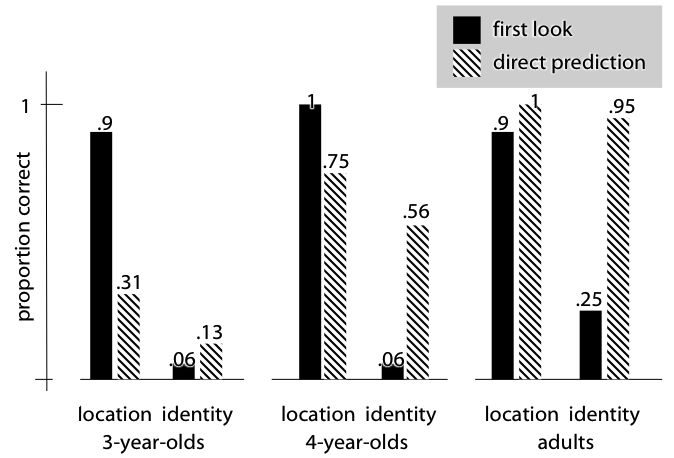Mindreading: Signature Limits, and Development
The method of signature limits enables us both to generate predictions from a dual process theory and to re-identify processes across groups (e.g. human adults and human infants; or humans and nonhumans).
If the slides are not working, or you prefer them full screen, please try this link.
Notes
What Is a Model?
A model is just a way some aspects of the world could be. A model of minds and actions is a way mental aspects of the world could be.
A model is something that can serve different purposes. Having a model does not commit you to using it for any particular purpose. The model’s usefulness does not depend only on its accuracy: the ease with which it can be used to imagine, build or navigate matters. The best model for a given set of purposes may not be the most accurate. Further, it can be advantageous to have multiple models of a single thing. For example, building a house can involve creating multiple models.
Theorists specify models in various ways including by giving a theory or by constructing something physical.
A model is distinct from a theory. A model can be used to make claims about the world, but the model itself entails nothing about how the world actually is. By contrast, a theory does (Godfrey-Smith, 2005).
In saying that an individual or a process relies on a model, we are attempting to capture the way aspects of the world seem from the individual’s or processes’ point of view. There is no commitment to any claim about how the model relates to the individual or process. There is no suggestion, in saying that an individual relies on a model, that they have a physical model; nor that they know any of a theory which we, as theorists, use to specify the model.
Signature Limits
A signature limit of a model is a set of predictions derivable from the model which are incorrect, and which are not predictions of other models under consideration.
Automatic belief-tracking in adults, and belief-tracking in infants, are both subject to signature limits associated with minimal theory of mind (Wang, Hadi, & Low, 2015; Low & Watts, 2013; Low, Drummond, Walmsley, & Wang, 2014; Mozuraitis, Chambers, & Daneman, 2015; Edwards & Low, 2017; Fizke, Butterfill, Loo, Reindl, & Rakoczy, 2017; Oktay-Gür, Schulz, & Rakoczy, 2018; Edwards & Low, 2017; Edwards & Low, 2019; contrast Scott, Richman, & Baillargeon, 2015).
 Figure: Signature limits illustrated. A response-by-content interaction that is robust across age-groups. Source: redrawn from Low & Watts (2013)
Figure: Signature limits illustrated. A response-by-content interaction that is robust across age-groups. Source: redrawn from Low & Watts (2013)
Objections
-
Low & Watts (2013) is replicable, but the paradigm involves confounds and so the results do not provide good evidence of belief tracking (Kulke, von Duhn, Schneider, & Rakoczy, 2018).1
-
Infant belief-tracking is not subject to the signature limit about identity (Scott et al., 2015).
-
‘the theoretical arguments offered […] are […] unconvincing, and […] the data can be explained in other terms’ (Carruthers, 2015; see also Carruthers, 2015a).
Glossary
References
Endnotes
-
Kulke et al. (2018) argue that although the paradigm from Low & Watts (2013) replicates, attempts to modify it to avoid confounding factors do not produce comparable results. In full:
‘There are two broad possibilities why only the Low and Watts (2013) paradigm was robustly replicated. One possibility is that this paradigm is particularly valid (perhaps because of lower processing demands or other relevant task factors) and therefore the most sensitive and suitable one to tap implicit theory of mind. The contrary possibility is that this task may be particularly prone to alternative explanations because of potential confounds’ (p. 8)
This motivated them to consider modified versions of the paradigm avoiding confounds, but:
‘the original pattern of belief-congruent looking could be reproduced only under conditions in which the belief congruency of the locations is confounded with additional factors, and therefore, this pattern might not reflect belief-based anticipation’ (p. 9)